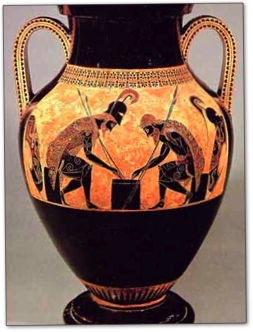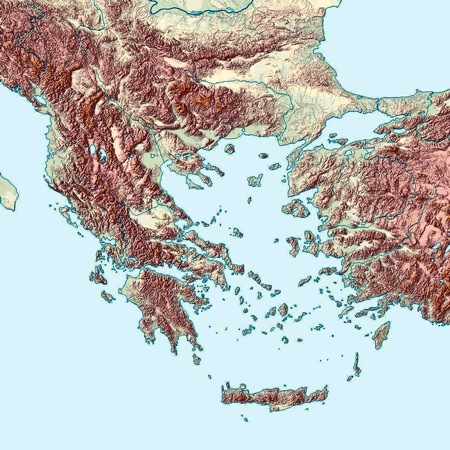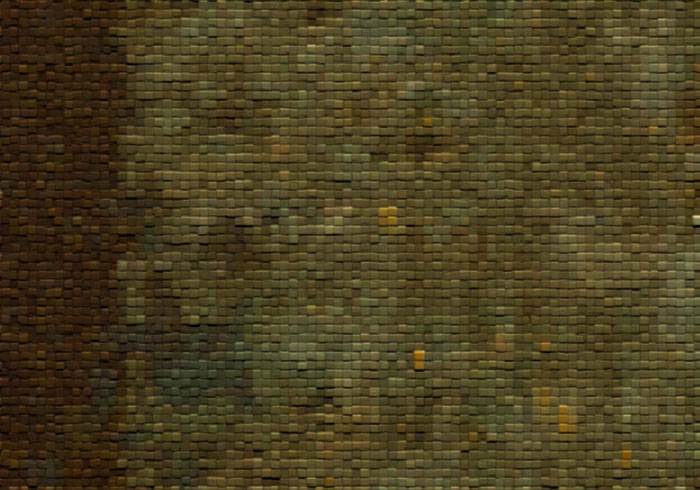


The Greeks flourished from around 800 to 323 B.C. In this period, the Greeks made an enormous contribution to the growth of European civilization. European development has fallen and risen, changed and adjusted considerably since Greek times, but many of the intellectual and political roots of the modern world can be traced back to the Greek city-states. Before we turn to those roots, we need to examine the region where Greek civilization developed.
Introduction

Geography of the Aegean
The main center of Greek life lies at the east end of the Mediterranean, where it meets the Black Sea. The major land areas consist of two large peninsulas that run roughly at right angles to each other. The first is the Anatolian Peninsula or Asia Minor. It juts out from east to west. The other is the Balkan Peninsula, which extends roughly southward from the main mass of Europe.
Most of modern Greece is in the southern Balkan Peninsula; but in ancient times, the heart of Greece was actually the body of water between the Balkans and Anatolia. It is the Aegean Sea. Ancient Greeks lived all around the coasts of the Aegean, including the western end of Anatolia, and on numerous islands that are scattered between Europe and Asia. In the classical period, the most advanced and historically important Greek communities were those that bordered the Aegean.


The Aegean World
Topographically, the Aegean region is tortured and complex. The land areas were formed recently in geologic time as mountains were pushed up form the sea where two plates of the earth rub together. The process is still going on. Even today, there is some volcanic activity, and earthquakes are fairly common. The Balkan Peninsula is the top of a mountain chain that has been thrust up, and the Aegean islands are peaks of mountains that have not yet fully emerged. The interior of Anatolia is also a high mountainous region; that kept Greek settlement confined to the coastal fringe and the river valleys that ring Asia Minor. Because it is so mountainous, only about 20 percent of the land is level enough for farming, and the farmlands are broken up into many small valleys and plains separated from each other by natural barriers. It is hard to travel between settled areas by land. But it was possible to sail from place to place since most lived near the sea. In comparison to other ancient peoples, therefore, the Greeks came fairly early to rely less on farming to make a living and more on maritime activities, such as fishing and trade.
This brings me to another important geographical factor that shaped Greek development. It is the relation between the Aegean and other lands around the Eastern Mediterranean. By land, the Aegean was relatively isolated from neighboring regions; this protected the area from hostile invasion in the early period. It was possible to move down the Balkan Peninsula from Europe proper. The Greeks themselves did that at some point. But there are only a few passes, and such invasions are not easy. The mountainous center of Anatolia makes landward movement from the east difficult as well. Eventually, non-Greek peoples did come to threaten the Aegean from that direction, as we shall see. Yet that only happened after the interior of Asia Minor fell under the control of advanced, well-organized states, which did not occur until relatively late in Greek history.
On the other hand, the Aegean could be reached fairly easily by sea. Fortunately, maritime contacts were much less likely to be hostile invasions. At first, they mainly involved trade. In fact, peaceful communication with the Aegean by sea began very early and most of that communication linked the Aegean with the Ancient Near East. That was extremely important.
True civilization frost emerged in the Near East. Egypt had a thriving civilization as early as 2800 B.C. After 2000, civilized centers also spread to the east coast of the Mediterranean and to Anatolia. These civilizations used bronze as the main metal for implements. Thus, the first period of civilization is called the Bronze Age. It extended down to about 1100 B.C., when the Iron Age began.
The remains of trade goods show that the peoples of the Aegean were in regular contact with the Near East from the mid-2000s to the end of the Bronze Age. That is important for two reasons. The first is scholarly. We have a much clearer and better-dated picture of development in the Near East during the Bronze Age than we do Aegean. I will suggest later why that is useful. The second reason is historical. Contact with the Near East was a major factor in introducing a more advanced, civilized way of life into the Aegean in the Bronze Age. The point is that the Aegean was accessible enough to more advanced lands to be open to influences that promoted stronger institutions, better technical skills and intellectual improvements. But I was remote enough so that Near Eastern societies could not menace the region politically and militarily until much later.




